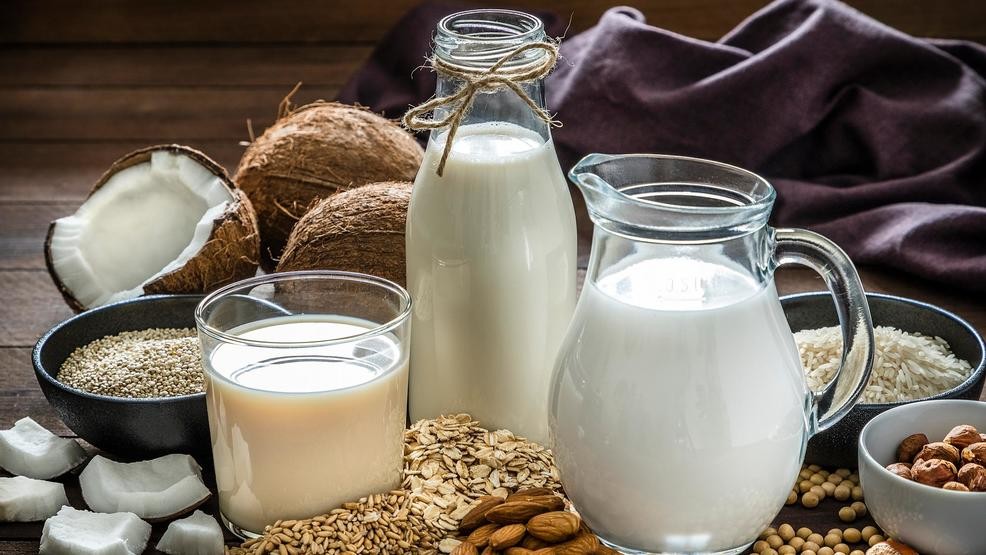The popularity of vegetarianism and veganism over the past decade has increased drastically with a huge increase in interest in just 2 years.
Many UK consumers are making conscious decisions based on health and the environmental impact of eating animal products. In 2020 we saw a wide range of dairy free alternatives entering the market.
This movement towards a more ethically sourced, sustainable, and healthier diet has resulted in large-scale change across the country in the food and drink industry. A plethora of plant-based drinks can now be found in cafes, coffee shops, supermarkets, and delis.
I will present some of the best vegan alternatives available for coffee and hot drinks, with tips and tricks on how to use them.
I will be focusing mainly on plant-based milks in this blog, however there are other vegan alternatives to pair with coffee, such as syrups and hot chocolate.
Vegan food products aim to lessen the environmental and ethical impacts of meat and dairy industries.
By offering an alternative to milk, greenhouse emissions are expected to decline, less animals will be exploited for dairy products and more green land and space will be available for other more important resources.
There is also a multitude of health benefits from consuming plant-based milks as they contain less saturated fat, have a higher protein content and many more valued nutrients.
Here is a list of the main vegan milk options available:
Soy
2017 saw the rise of soy milk! In 2017, 123.6 million hectares of land was used to grow 352.6 tonnes of soybeans. That’s a lot of land — an area bigger than South Africa — and a lot of soybeans. Even with its popularity some consumers questioned whether the rise in demand for soy milk was ethical. 70% of the world’s soy is used as food to feed farmed chickens, pigs, cows and various fish. In 2017, 18% of soy was being used to make biodiesel in the EU and the remainder was being used for human consumption. Hence, eating soy products is not the most significant driver of current soy production, although it is ever increasing.
Soybeans are a highly profitable business, with most of the world’s supply is grown in three main countries: the USA (40%), Brazil (35%) and Argentina (25%).
Soy milk is quite possibly the most popular vegan milk alternative, even before the Vegan boom of 2018.
This scrumptious alternative is made by adding filtered water to ground up soybeans, then filtering out the remaining beans after being heated. Soybeans are also used to make the vegan friendly tofu, which is why soya milk has such a high protein content.
This also makes it considerably friendly to baristas and café owners alike, which is most likely why it was the first plant-based milk to be seen in coffee shops in the UK.
Due to the high percentage of protein, foam is easily made when frothing the milk and it hold nicely in the pitcher before pouring.
Soy milk also has a light taste, so it does not conceal the flavour of the coffee, making it one of the best vegan alternatives to add to your morning brew.
Almond
Almond milk has had some bad press since 2018.
About 80 percent of almonds are produced in California, which is a state that struggles with drought and dry conditions. Since it takes about 15 gallons of water to produce just 16 almonds, almond milk production has the potential to take a massive toll on California’s environment.
Already in 2020, agricultural regions in San Joaquin Valley are suffering heavily from groundwater depletion, which has resulted in the ground levels sinking, thanks to the almond industry's liberal use of limited water supplies across the state.
California’s honeybees are dying at alarming rates to fuel the high demand in almond production (that’s 50 million bees a year). The honeybees are being used earlier in the year when they would normally remain dormant but cannot find a source of food as there are not enough flowers in bloom at that cold time of the year.
It is not the severe lack of food or water that is the biggest killer here — it is the harsh pesticides used by all of California’s commercial farmers in their fields, even those from other agricultural industries. Pesticides, including clothianidin and dicamba, can work to slowly impact the honeybees' immune systems and their natural reproductive cycles. These pesticides are supplied to the almond farmers by no other than the Bayer owned chemical giant, Monsanto, who receive hundreds of lawsuits and bad press news articles a year.
Made by soaking sweet almonds in water, almond milk is a great vegan alternative for taste.
The nutty flavour of almond milk can complement some coffees very well and works great in hot chocolates and mochas.
Although low in protein, almond milk can steam very well if a small amount of air is shaken into the carton before being dispensed into the pitcher.
Sweetened almond milk offers a richer taste for those wanting to indulge.
Coconut
Coconuts originally come from Southeast Asia and India but because the coconuts float, they were carried to coastlines all over the Pacific Ocean. Coconuts successfully made their homes in all the subtropical places they could find. Humans further contributed to the varietal spread across the Atlantic and now coconut palm trees grow in almost all subtropical coastal zones around the world.
Coconut milk is the creamy, silky liquid that comes from grated coconut flesh. It can be very thick and creamy or thinner and more dairy-like. It has been one of the main ingredients in Asia, the Caribbean and northern South America for millennia in some places, such as India. As innocent as coconut milk may seem, the pressure to meet global demand often leaves workers exploited and rainforests destroyed.
High in fat and electrolytes, coconut milk offers a luscious flavour whilst still being uber healthy.
However, as coconut milk does have a unique flavour profile it can alter the taste of coffee and doesn’t always cooperate with people who use it. Some barista-edition coconut milks are available with stabilisers, which carry a thinner consistency making it easier to foam.
Oat
As far as environmentally and ecologically friendly choices go, oat milk could be one of the most viable alternatives. Oats are mostly grown in colder areas of the world like Canada, Finland, Poland and Scandinavia, so growing large quantities of oats does not require the same levels of deforestation that many other crops ( I’m looking at you, coconut milk) do.
Oat popularity as a breakfast go to has increased over the last 3 years with many companies cashing in. You can find oats in everything from breakfast bars to pie toppings. Oats are full of dietary fibre that helps your metabolism get going in the morning. Oat milk has a delicious sweet yet satisfying flavour and makes a lush combination with coffee.
The oats are first soaked in water, blended, and then filtered. It is key to note that gluten free oats are used in oat milk production which makes it suitable for coeliacs. Oat milk is a bit of an aberration next to the other mainstream plant-based milks like almond and soy milk. As oats are a grain — almond milk and soy milk both have a similar nutritional profile because they are derived from protein-rich, fatty nuts and legumes.
Oats have a quite different composition though, due to the fact that they are much higher in carbohydrates with the average serving of unsweetened oat milk containing around 16 grams of carbohydrates.
Soy milk can have anywhere from 3 to 15 grams per serving, depending on the brand and whether it is sweetened, and coves milk usually has 11 to 13 grams.
Baristas all over the world are becoming oat milk converts, as the oat milk's neutral flavour profile accommodates itself well to creamy espresso-based beverages like mochas, lattes, and flat whites. More importantly, oat milk froths up well when you steam it, creating the perfect micro-foam for a non-dairy cappuccino.
Tips When Using Plant-Based Milks
Many people across the world will be used to using dairy and will have to adapt their approach when using some plant-based milks due to their fat content.
Many plant milk companies have created “barista edition” milks, which often have added stabilisers in, that prevent it from splitting when heated. Despite the addition of these stabilisers, temperature difference can often still cause this splitting. To avoid this, add a dash of cold oat/soy milk to the espresso to help incorporate the two together.
Controlling temperature is especially important, soy milk which is heated to a remarkably high temperature will denature the proteins, again causing splitting – which is a very grainy texture.

